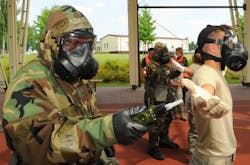Navy asks industry to develop large unmanned submarine able to operate independently for more than two months
Autonomy involves autonomy software, computer hardware, and sensors. Endurance, meanwhile, pertains to UUV propulsion technology that can operate independently for tens of hours to months. Each effort to develop autonomy technologies and endurance technologies will have two phases.
The autonomy effort's first phase will last for 18 months with a six-month option. For this phase, Navy researchers want contractors involved to develop autonomy hardware and software for missions that last as long as 30 days at depths from 100 to 400 feet. Operators may intervene over satellite links if the mission becomes too complicated, and the Navy may provide a full-scale UUV prototype for this phase.
In the autonomy effort's second phase, which will last from one to three years, the Navy wants to develop autonomy hardware and software for missions lasting more than 70 days in the open ocean, as well as in coastal waters and harbors, without any human interaction while in operating areas.
The UUV in this phase must be able to avoid all vessels in the area, including fishing boats. Demonstration challenges will include detecting and avoiding undersea stationary and moving obstacles, as well as path planning algorithms to minimize energy consumption while avoiding obstacles; detecting, locating, and identifying surface vessels; determining the intent of detected surface vessels; and detecting and avoiding all kinds of fishing nets and fishing gear, including mono-filament and twine nets which are difficult to detect. Once outside the specified areas, human operators may intervene over satellite links if necessary.
The endurance effort's first phase, which will be for two years and a six-month option, will develop UUV propulsion for missions as long as 30 days. The second phase, which will last from one to three years, will develop UUV propulsion for missions lasting at least 70 days, including open-ocean transits. The Navy will provide time government-operated large UUV prototype for at sea testing.
For technical questions or concerns, contact the Navy's Daniel Deitz, the LDUUV INP program officer, by e-mail at [email protected], or by post at Ocean Battlespace Sensing, Code 321, Office of Naval Research, One Liberty Center, 875 North Randolph St., Arlington, Va. 22203-1995. For business questions contact Contract Specialist Michael Boyle by e-mail at [email protected], or by post at the address above.
More information is online at https://www.fbo.gov/spg/DON/ONR/ONR/ONRBAA11-025/listing.html.
Related stories
-- UUV mothership to deploy intelligence-gathering unmanned underwater vehicles in development by SAIC;
-- Unmanned underwater vehicle machine autonomy seeks to detect and avoid fishing nets and kelp beds.

